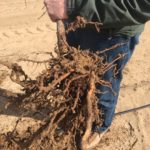Written and provided by UC IPM. Link to the original article (click here).
In brief:

- Peach root-knot nematode is newly discovered in California, but its current distribution is unknown.
- Peach root-knot nematode is capable of infecting most Prunus rootstocks currently used in almond and stone fruit production. Rootstocks resistant to previously detected root-knot nematodes may not be resistant to peach root-knot nematode.
- The California Department of Food and Agriculture rated this nematode as an A quarantine-actionable pest. Contact your local county agricultural commissioner’s office if you suspect you have peach root-knot nematode (uneven and poor tree growth, stunting, and root galls on resistant rootstocks).
The peach root-knot nematode (Meloidogyne floridensis) was recently discovered in California and has the potential to infect many of California’s economically important crops. At the time of this writing, it is not clear how wide-spread this nematode is in California. The California Department of Food and Agriculture (CDFA) rated this nematode as an A quarantine-actionable pest.
Since the early 1960s, the rootstock Nemaguard and others such as Marianna 2624 and Myrobalan 29C, have protected Prunus crops (almond and stone fruits) from attack by southern root-knot nematodes (M. arenaria, M. incognita, and M. javanica), which are common in California. In contrast, peach root-knot nematode is capable of infecting Nemaguard and peach-almond hybrids. Research in Florida has identified some differences in response among Prunus rootstocks, but peach root-knot nematode itself has variability that allows some populations of it to infect peach and peach-almond hybrids rootstocks that are currently used in California.
A consortium of University of California (UC) Cooperative Extension, UC Riverside and CDFA is working with the county agricultural commissioners of the affected counties, the growers, respective crop consultants, and the Almond Board of California to mitigate the potential impacts of peach root-knot nematode. Emphasis will be on containing and treating the currently known infestations and assessing the distribution within California. Contact your local county agricultural commissioner’s office if you suspect you have peach root-knot nematode.
An almond orchard with peach root-knot nematode was first detected by UC Cooperative Extension Advisor David Doll in Merced County. Doll was called to the field because of observed uneven, unthrifty (poor) growth and stunting of 2-year-old plants. Doll involved UC Cooperative Extension Specialist Andreas Westphal to identify the cause of the problem in this orchard. Westphal took diagnostic samples to confirm root-knot nematodes on Hansen 536, a rootstock that carries resistance to many known root-knot nematodes in California. On all stunted plants, severe galling typical for root-knot nematode infection on the Hansen 536 rootstock warranted continued identification of the nematode. Westphal involved taxonomists Sergei Subbotin and John Chitambar from the CDFA Nematology Lab to confirm the identification morphologically and molecularly by established protocols. They identified the nematode to be Meloidogyne floridensis, the peach root-knot nematode. About one month later, a second detection was made in a limited area in Kern County facilitated by Advisor Mohammad Yaghmour (UC Cooperative Extension Kern County).
The peach root-knot nematode was first described in Florida where it is a wide-spread pest in Prunus orchards, primarily in peach plantings. In general, root-knot nematodes are especially troublesome because they can infect many different host species. These microscopic soil-dwelling nematodes live in soil from where they infect their plant hosts. In susceptible host plants, they undergo an intricate interaction with the physiology of the plant, and ultimately induce the plant to generate the name-giving knots and deformations in the root system. These knots and deformations impair the uptake of nutrients and water by the plant and may increase infection by plant pathogens.
Resources:
Direct link: https://www2.ipm.ucanr.edu/Invasive-and-Exotic-Pests/Peach-Root-Knot-Nematode/
California Department of Food and Agriculture Pest Ratings Proposals and Final Ratings: Meloidogyne floridensis Handoo et al., 2004. Accessed November 07, 2018. http://blogs.cdfa.ca.gov/Section3162/?p=5666


MAXWELL NORTON
December 21, 2018Any data on Viking RS yet?
David Doll
December 31, 2018Maxwell,
We do not have any data on this or other rootstocks at this time. Trials are being established. Hansen 536 and Nemaguard have shown susceptibility. We suspect any rootstock with Nemaguard parentage will be susceptible.
David
Greg Berg
January 11, 2019Has it been traced back to the previous crop or perhaps from the nursery?
David Doll
January 21, 2019Greg,
No, it hasnt. We dont know how this pest was introduced at this point.
Wish we knew more,
David